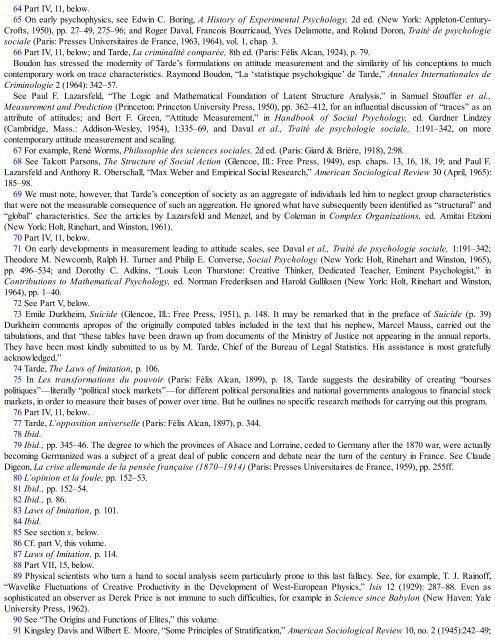3658925934
Create successful ePaper yourself
Turn your PDF publications into a flip-book with our unique Google optimized e-Paper software.
64 Part IV, 11, below.<br />
65 On early psychophysics, see Edwin C. Boring, A History of Experimental Psychology, 2d ed. (New York: Appleton-Century-<br />
Crofts, 1950), pp. 27–49, 275–96; and Roger Daval, Francois Bourricaud, Yves Delamotte, and Roland Doron, Traité de psychologie<br />
sociale (Paris: Presses Universitaires de France, 1963, 1964), vol. 1, chap. 3.<br />
66 Part IV, 11, below; and Tarde, La criminalité comparée, 8th ed. (Paris: Félix Alcan, 1924), p. 79.<br />
Boudon has stressed the modernity of Tarde’s formulations on attitude measurement and the similarity of his conceptions to much<br />
contemporary work on trace characteristics. Raymond Boudon, “La ‘statistique psychologique’ de Tarde,” Annales Internationales de<br />
Criminologie 2 (1964): 342–57.<br />
See Paul F. Lazarsfeld, “The Logic and Mathematical Foundation of Latent Structure Analysis,” in Samuel Stouffer et al.,<br />
Measurement and Prediction (Princeton: Princeton University Press, 1950), pp. 362–412, for an influential discussion of “traces” as an<br />
attribute of attitudes; and Bert F. Green, “Attitude Measurement,” in Handbook of Social Psychology, ed. Gardner Lindzey<br />
(Cambridge, Mass.: Addison-Wesley, 1954), 1:335–69, and Daval et al., Traité de psychologie sociale, 1:191–342, on more<br />
contemporary attitude measurement and scaling.<br />
67 For example, René Worms, Philosophie des sciences sociales, 2d ed. (Paris: Giard & Brière, 1918), 2:98.<br />
68 See Talcott Parsons, The Structure of Social Action (Glencoe, Ill.: Free Press, 1949), esp. chaps. 13, 16, 18, 19; and Paul F.<br />
Lazarsfeld and Anthony R. Oberschall, “Max Weber and Empirical Social Research,” American Sociological Review 30 (April, 1965):<br />
185–98.<br />
69 We must note, however, that Tarde’s conception of society as an aggregate of individuals led him to neglect group characteristics<br />
that were not the measurable consequence of such an aggreation. He ignored what have subsequently been identified as “structural” and<br />
“global” characteristics. See the articles by Lazarsfeld and Menzel, and by Coleman in Complex Organizations, ed. Amitai Etzioni<br />
(New York: Holt, Rinehart, and Winston, 1961).<br />
70 Part IV, 11, below.<br />
71 On early developments in measurement leading to attitude scales, see Daval et al., Traité de psychologie sociale, 1:191–342;<br />
Theodore M. Newcomb, Ralph H. Turner and Philip E. Converse, Social Psychology (New York: Holt, Rinehart and Winston, 1965),<br />
pp. 496–534; and Dorothy C. Adkins, “Louis Leon Thurstone: Creative Thinker, Dedicated Teacher, Eminent Psychologist,” in<br />
Contributions to Mathematical Psychology, ed. Norman Frederiksen and Harold Gulliksen (New York: Holt, Rinehart and Winston,<br />
1964), pp. 1–40.<br />
72 See Part V, below.<br />
73 Emile Durkheim, Suicide (Glencoe, Ill.: Free Press, 1951), p. 148. It may be remarked that in the preface of Suicide (p. 39)<br />
Durkheim comments apropos of the originally computed tables included in the text that his nephew, Marcel Mauss, carried out the<br />
tabulations, and that “these tables have been drawn up from documents of the Ministry of Justice not appearing in the annual reports.<br />
They have been most kindly submitted to us by M. Tarde, Chief of the Bureau of Legal Statistics. His assistance is most gratefully<br />
acknowledged.”<br />
74 Tarde, The Laws of Imitation, p. 106.<br />
75 In Les transformations du pouvoir (Paris: Félix Alcan, 1899), p. 18, Tarde suggests the desirability of creating “bourses<br />
politiques”—literally “political stock markets”—for different political personalities and national governments analogous to financial stock<br />
markets, in order to measure their bases of power over time. But he outlines no specific research methods for carrying out this program.<br />
76 Part IV, 11, below.<br />
77 Tarde, L’opposition universelle (Paris: Félix Alcan, 1897), p. 344.<br />
78 Ibid.<br />
79 Ibid., pp. 345–46. The degree to which the provinces of Alsace and Lorraine, ceded to Germany after the 1870 war, were actually<br />
becoming Germanized was a subject of a great deal of public concern and debate near the turn of the century in France. See Claude<br />
Digeon, La crise allemande de la pensée française (1870–1914) (Paris: Presses Universitaires de France, 1959), pp. 255ff.<br />
80 L’opinion et la foule, pp. 152–53.<br />
81 Ibid., pp. 152–54.<br />
82 Ibid., p. 86.<br />
83 Laws of Imitation, p. 101.<br />
84 Ibid.<br />
85 See section x, below.<br />
86 Cf. part V, this volume.<br />
87 Laws of Imitation, p. 114.<br />
88 Part VII, 15, below.<br />
89 Physical scientists who turn a hand to social analysis seem particularly prone to this last fallacy. See, for example, T. J. Rainoff,<br />
“Wavelike Fluctuations of Creative Productivity in the Development of West-European Physics,” Isis 12 (1929): 287–88. Even as<br />
sophisticated an observer as Derek Price is not immune to such difficulties, for example in Science since Babylon (New Haven: Yale<br />
University Press, 1962).<br />
90 See “The Origins and Functions of Elites,” this volume.<br />
91 Kingsley Davis and Wilbert E. Moore, “Some Principles of Stratification,” American Sociological Review 10, no. 2 (1945):242–49;









![Genki - An Integrated Course in Elementary Japanese II [Second Edition] (2011), WITH PDF BOOKMARKS!](https://img.yumpu.com/58322134/1/180x260/genki-an-integrated-course-in-elementary-japanese-ii-second-edition-2011-with-pdf-bookmarks.jpg?quality=85)
![Genki - An Integrated Course in Elementary Japanese I [Second Edition] (2011), WITH PDF BOOKMARKS!](https://img.yumpu.com/58322120/1/182x260/genki-an-integrated-course-in-elementary-japanese-i-second-edition-2011-with-pdf-bookmarks.jpg?quality=85)





